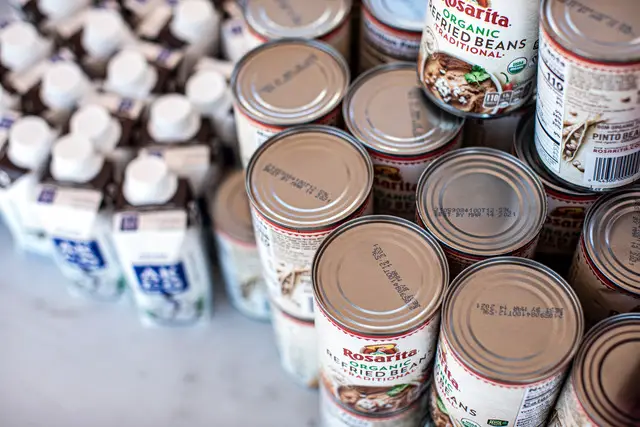REGION — With the spread of COVID-19 resulting in thousands of layoffs throughout the county, Feeding San Diego is making “dramatic changes” to ensure San Diegans can put food on the table.
The organization is operating over 150 meal distribution sites throughout San Diego County, partnering with local charitable organizations and school districts to make sure kids and families have access to food through these uncertain times.
The local branch of a national organization, Feeding San Diego typically focuses on bringing meals to underserved populations — seniors, the homeless, and kids who might not otherwise have access to school lunches, to name a few. But now the organization is upping its distribution by as much as 40% to bring services to an entirely new demographic.
“We have a fast-growing new population of food insecure San Diegans — mainly from kids who have lost access to school meals, and the many, many workers who have been laid off,” said Feeding San Diego CEO Vince Hall. “Those folks are making really tough choices between paying their rent and buying food…I’m proud that FSD is there to help them meet their nutritional needs while they deal with so many other hardships.”
As a result of this growing demand, the organization has needed to “reinvent the current distribution,” Hall said, comparing the process to “rebuilding the airplane while you’re flying, and also making it bigger and faster.”
Feeding San Diego gets most of its food as “surplus” – they rescue about 12 million pounds of food a year from grocery stores, cafes, and restaurants. However, the organization has faced a unique challenge as of late due to restaurant closures and bouts of panic buying in communities – as a result, the surplus has been slim.
To meet the soaring demand, they have had to purchase a “tremendous amount” of food from national food manufacturers, said Hall. But they’ve also received a generous amount of perishable and non-perishable food items from restaurants that have been closed down due to state mandates.
“We are sourcing food from places that we’ve never sourced it from before and acquiring food in new and innovative ways,” he said. “We ‘re going to keep those supply lines open as long as this crisis lasts.”
Hall wants families to know they do not need to “qualify” for the organization’s distribution services, nor do they need to fill out any forms that might stigmatize the process. Anyone can drive up to one of the distribution sites during the allotted hours and get the food they need.
“We’re here to serve everyone,” he said.

There are plenty of sites across both North County inland and coastal – including St. Peter’s Episcopal Church in Del Mar, the Community Resource Center in Encinitas and Foundry Food Pantry in Vista – and well over a dozen more. According to Hall, the organization has been able to increase its outreach in North County due to support from the Leichtag Foundation, a nonprofit based in Encinitas.
Hall said the county’s new reality has required the organization to adapt to the needs of San Diegans – including those who are already accustomed to receiving Feeding San Diego’s services. This has meant figuring out how to deliver prepared meals to seniors and getting meals to children who previously relied on school breakfasts and lunches.
For example, the organization launched special meal distributions for children this past week – with eight sites throughout the county. They have also set up “emergency sites” in addition to their typical locations – in Oceanside, Chula Vista and Ramona (see link below for more details).
The organization has seen a dip in the number of volunteers – many of whom have needed to be cut temporarily in order to help maintain social distancing standards. The organization has begun relying on Community Emergency Response Team volunteers to help fill shifts at the organization’s many distribution sites, although community members have also begun to reach out to ask how they can get involved.
“This is a community that rallies together during a crisis,” Hall said.
If readers are interested in volunteering, they can visit justserve.org/sdcounty.
The organization is also looking to raise funds, so they can help continue their services for as long as the crisis lasts. Hall said Feeding San Diego is planning and preparing for a “longer-term scenario,” while still remaining optimistic.
“I would say we’re hoping for the best, but planning for the worst,” he said.
If you are interested in donating, visit: https://feedingsandiego.org/get-involved/donate-funds/
For North County residents hoping to visit FSD’s special meal distributions for children and teens, hot meals are available for children Monday and Friday at the following locations and times:
Boys and Girls Club San Marcos (1 Positive Pl., San Marcos, CA 92069) at 3 p.m;
Sierra Vista Apartments (422 Los Vallecitos Blvd., San Marcos, CA 92069) at 12 p.m.;
Mission Cove Apartments (3239 Conch Way, Oceanside, CA 92058) at 12 p.m.;
Pro Kids Oceanside (821 Douglas Dr., Oceanside, CA 92058) at 11 a.m.
For a map of the organization’s regular and emergency food distribution sites and their hours of operation, visit: https://feedingsandiego.org/need-help/food-distributions/. The organization is keeping in line with safety guidelines, and as such all sites are operating either as drive-thru’s, grab-and-go’s (maintaining social distancing), or by appointment.


